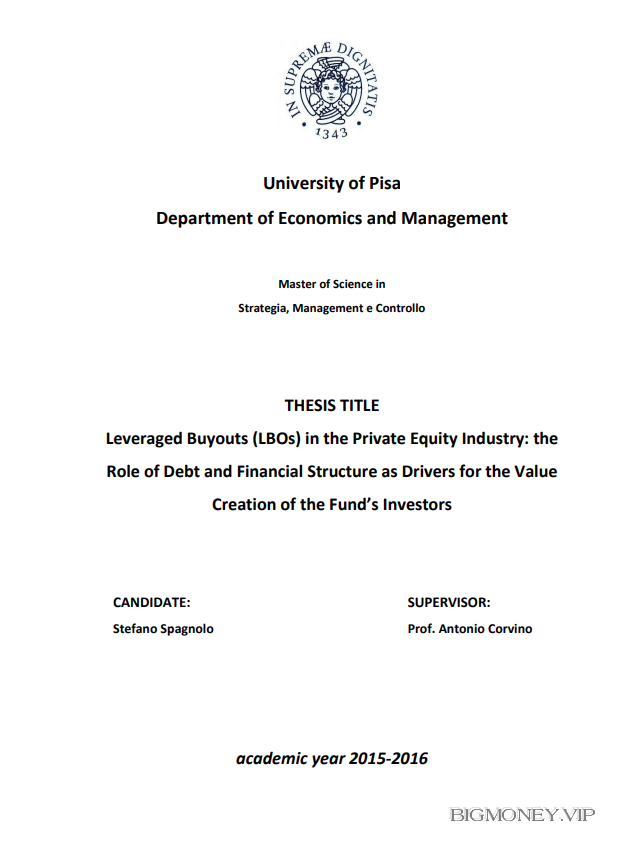Leveraged Buyouts (LBOs) in the Private Equity Industry: the Role of Debt and Financial Structure as Drivers for the Value Creation of the Fund’s Investors by Stefano Spagnolo

Part I – An Overview of Private Equity
1.1 What is Private Equity?
“I like to define private equity firms as organizations
that run governance that run businesses”
(Michael H. Jensen)
Private Equity (PE) is a relatively recent phenomenon that has been widely defined
by academics, scholars and practitioners over time. Many definitions of this
financial activity can be found on books, papers and academic articles, as well as
those provided by authoritative associations worldwide that deal with this topic.
Regardless of the variety and the number of these different explanations, Private
Equity activity can be generally defined as the purchase of control equity stakes in
unquoted companies that are characterized for high growth potential, with the aim
of actively managing, thereby realizing value creation, and then reselling them on
the market gaining as much as possible. More specifically, it is a medium to long-
term investment that, by strengthening management expertise, delivering
operational improvements and bringing in financial resources, leads the company
to create value on a long-term perspective, which is then monetized by selling back
the firm on the market.
Private Equity as an Alternative Investment asset class
Although put it in these terms Private Equity appears to be somewhat of a typical
and not excessively sophisticated financial activity, it is by contrast encompassed
within the alternative investments category, as shown even in the new report of the
World Economic Forum. In other words, financial investments can be easily
divided into two macro categories, the first of them being “traditional
investments”, which comprise typical investments in cash, stocks (private or
public) and bonds (government or corporate), that is, asset classes with which
investors are most familiar with and the easiest and most accessible to find on the
markets. On the other side, the “alternative investments” category is made up of
all the other and more sophisticated asset classes, which are often not even known
by the majority of people without adequate financial expertise, such as
commodities, real estate, even art and antiquities, as well as private equity, venture
capital and hedge funds investments. Besides the mere asset class on which they
are based on, alternative investments are usually characterized by illiquidity, long-
term ranges and high risk that make them highly specialized and suitable only for
a little portion of investors.
Private Equity categories
Private equity investments cannot be considered as a unique, single class. Indeed,
it gathers many different subsets of very dissimilar investments that need to be
separately analyzed to better understand this phenomenon. Specifically, the main
classification splits private equity into different investment categories, each of
them refers to a different stage of the life cycle of the company and requires capital
for a specific purpose. Academics and practitioners have hitherto given different
categorizations and taxonomies of the various types of investments to be collected
below the private equity macro class, and, as easily predictable, several differences
have emerged, especially between U.S. and European terminologies. With the
clear objective of making things simpler, we will report here the most common
and worldwide accepted stages that characterize the various private equity classes,
highlighting their utilization nowadays. According to the British Private Equity &
Venture Capital Association (BVCA), one of the most authoritative PE




